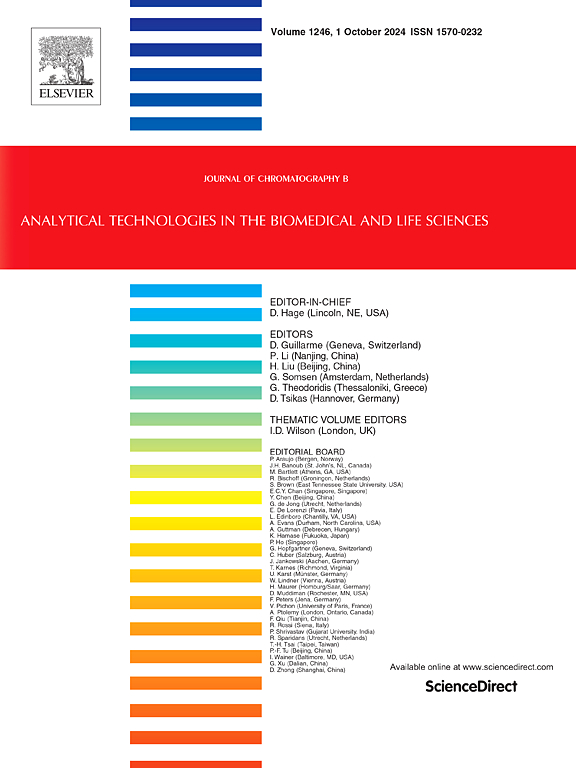Ultra-sensitive quantification of fipronil in zebrafish tissues via UPLC-MS3
IF 2.8
3区 医学
Q2 BIOCHEMICAL RESEARCH METHODS
引用次数: 0
Abstract
A sensitive and selective ultra-performance liquid chromatography-tandem mass spectrometry cubed (UPLC-MS3) assay was established for detection of fipronil in zebrafish tissue samples. Following protein precipitation pretreatment, the concentrations of fipronil in various zebrafish tissue samples were quantified by the developed UPLC-MS3 assay. Fipronil was monitored by MS3 transition (m/z 435.0 → 398.9 → 330.0) with a ± 1.0 Da isolation window for secondary product ions. Chromatographic separation was achieved with 0.1 % formic acid-water (v/v) as the aqueous phase and acetonitrile as the organic phase. Gradient elution with C18 column was employed for separation of fipronil and probenecid (internal standard, IS). Method validation demonstrated excellent linearity over the range of 0.1–10 ng/mL (r2 > 0.995), with the accuracies ranging from −10.33 % to 3.17 % and precisions between 3.25 % and 11.34 %. Consistent extraction recoveries (89.92–113.49 %) and acceptable matrix effects (92.54–110.27 %) were observed across all tested matrices. The implementation of MS3 scanning significantly enhanced specificity by eliminating endogenous interference compared to conventional MRM detection. The successful application of this method in zebrafish tissue distribution studies confirmed its reliability for environmental toxicology research. This MS3-based approach provides a robust analytical platform for investigating biodistribution of fipronil in aquatic models.

UPLC-MS3超灵敏定量测定斑马鱼组织中氟虫腈
建立了一种灵敏、选择性的超高效液相色谱-串联质谱法(UPLC-MS3)检测斑马鱼组织样品中氟虫腈的方法。蛋白沉淀预处理后,采用开发的UPLC-MS3法定量测定各种斑马鱼组织样品中氟虫腈的浓度。氟虫腈采用MS3跃迁(m/z 435.0→398.9→330.0)监测,二次产物离子隔离窗口为±1.0 Da。以0.1%甲酸-水(v/v)为水相,乙腈为有机相进行色谱分离。采用C18柱梯度洗脱法分离氟虫腈和丙苯乙酯(内标,IS)。方法验证在0.1 ~ 10 ng/mL范围内线性良好(r2 >;0.995),准确度为- 10.33% ~ 3.17%,精密度为3.25% ~ 11.34%。提取回收率为89.92 ~ 113.49%,基质效应为92.54 ~ 110.27%。与传统MRM检测相比,MS3扫描通过消除内源干扰显著提高了特异性。该方法在斑马鱼组织分布研究中的成功应用证实了该方法在环境毒理学研究中的可靠性。这种基于ms3的方法为研究氟虫腈在水生模型中的生物分布提供了一个强大的分析平台。
本文章由计算机程序翻译,如有差异,请以英文原文为准。
求助全文
约1分钟内获得全文
求助全文
来源期刊

Journal of Chromatography B
医学-分析化学
CiteScore
5.60
自引率
3.30%
发文量
306
审稿时长
44 days
期刊介绍:
The Journal of Chromatography B publishes papers on developments in separation science relevant to biology and biomedical research including both fundamental advances and applications. Analytical techniques which may be considered include the various facets of chromatography, electrophoresis and related methods, affinity and immunoaffinity-based methodologies, hyphenated and other multi-dimensional techniques, and microanalytical approaches. The journal also considers articles reporting developments in sample preparation, detection techniques including mass spectrometry, and data handling and analysis.
Developments related to preparative separations for the isolation and purification of components of biological systems may be published, including chromatographic and electrophoretic methods, affinity separations, field flow fractionation and other preparative approaches.
Applications to the analysis of biological systems and samples will be considered when the analytical science contains a significant element of novelty, e.g. a new approach to the separation of a compound, novel combination of analytical techniques, or significantly improved analytical performance.
 求助内容:
求助内容: 应助结果提醒方式:
应助结果提醒方式:


